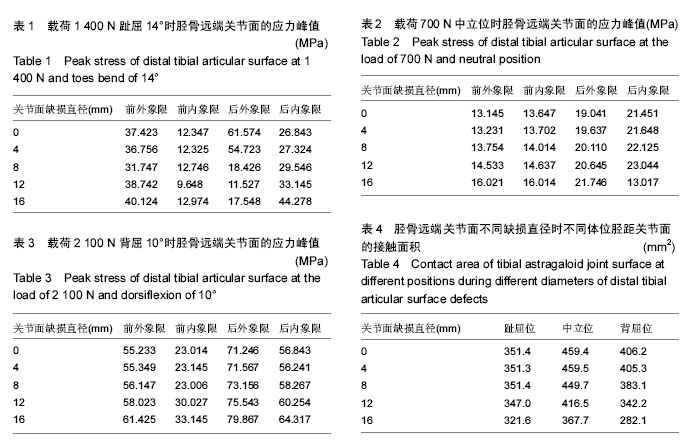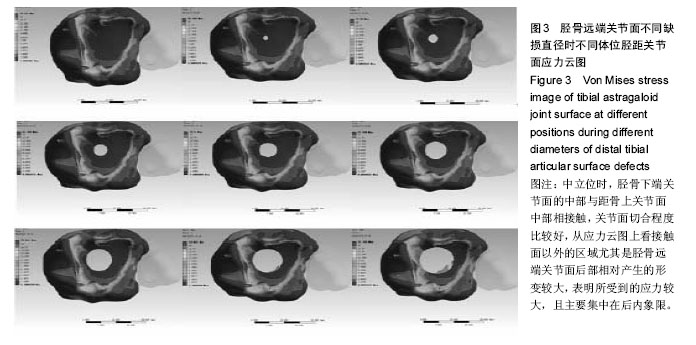| [1] 苏应军,童新延,胡力. 以踝关节解剖结构及生物力学特征分析慢性踝关节不稳[J]. 中国组织工程研究,2015, 19(15):2415-2419.
[2] Baumhauer JF.CORR Insights(®): How Do Hindfoot Fusions Affect Ankle Biomechanics: A Cadaver Model.Clin Orthop Relat Res. 2016;474(4):1017-1018.
[3] Hutchinson ID, Baxter JR, Gilbert S,et al.How Do Hindfoot Fusions Affect Ankle Biomechanics: A Cadaver Model.Clin Orthop Relat Res. 2016;474(4):1008-1016.
[4] 赵勇,王钢.踝关节扭伤的生物力学与运动学研究进展[J]. 中国骨伤,2015,28(4):374-377.
[5] 董伟强,余斌,白波.不同手术方式治疗踝关节韧带复合体损伤的生物力学评价[J].中国临床解剖学杂志,2015, 33(5):573-576.
[6] Hong YN, Shin CS. Gender differences of sagittal knee and ankle biomechanics during stair-to-ground descent transition.Clin Biomech (Bristol, Avon). 2015;30(10): 1210-1217.
[7] Hoch MC, Farwell KE, Gaven SL, et al.Weight-Bearing Dorsiflexion Range of Motion and Landing Biomechanics in Individuals With Chronic Ankle Instability. J Athl Train. 2015;50(8):833-839.
[8] 戴海飞,余斌,张凯瑞,等.踝关节周围韧带损伤对距骨稳定性影响的有限元分析[J].中国骨与关节损伤杂志,2012, 27(2):121-124.
[9] 孙卫东,温建民. 足部有限元建模方法应用现状[J]. 中国组织工程研究与临床康复,2010, 14(13):2457-2461.
[10] 陈灼彬,万磊. 医学有限元的建模方法[J]. 中国组织工程研究与临床康复,2007,11(31):6265-6267.
[11] 胡志刚,李洪波.仿真环境下医学器官的三维有限元建模方法[J].中国组织工程研究与临床康复,2011, 15(48): 8951-8954.
[12] 林旻中.特发性脊柱侧凸伴骨盆矢状位失衡有限元建模及三维矫形生物力学研究[D].中南大学,2013.
[13] 李劲松.有限元法模拟特发性脊柱侧凸后路矫形及内固定应力分析研究[D].中南大学,2013.
[14] Mackiewicz A, Banach M, Denisiewicz A,et al.Comparative studies of cervical spine anterior stabilization systems - Finite element analysis.Clin Biomech (Bristol, Avon). 2016;32:72-79.
[15] 原芳,薛清华,刘伟强. 有限元法在脊柱生物力学应用中的新进展[J]. 医用生物力学,2013, 28(5):585-590.
[16] 李伟,张宏,曹丽君,等. 脊柱腰段正常及骨质疏松三维有限元数字模型的建立[J]. 中国组织工程研究,2013, 17(9):1521-1526.
[17] Jaramillo HE, Gómez L, García JJ.A finite element model of the L4-L5-S1 human spine segment including the heterogeneity and anisotropy of the discs. Acta Bioeng Biomech. 2015;17(2):15-24.
[18] Henao J, Aubin CÉ, Labelle H, et al.Patient-specific finite element model of the spine and spinal cord to assess the neurological impact of scoliosis correction: preliminary application on two cases with and without intraoperative neurological complications. Comput Methods Biomech Biomed Engin. 2016;19(8):901-910.
[19] 郑杰,杨永宏,楼肃亮,等. 退变性脊柱侧弯的生物力学有限元分析[J]. 中国组织工程研究,2013, 17(30): 5490-5496.
[20] 钟俊青.股骨节段型人工假体设计的有限元研究[D].天津医科大学,2012.
[21] Torcato LB, Pellizzer EP, Verri FR, et al.Influence of parafunctional loading and prosthetic connection on stress distribution: a 3D finiteelement analysis.J Prosthet Dent. 2015;114(5):644-651.
[22] Sui X, Huang Y, Feng F,et al.3D finite element modeling of epiretinal stimulation: Impact of prosthetic electrode size and distance from the retina. Int J Artif Organs. 2015;38(5):277-287.
[23] 徐灵军,朱海波,张银网,等.活体人工髋关节假体植入位置的有限元分析[J].临床骨科杂志,2012,15(2):205-209.
[24] Shen Y, Li X, Fu X,et al.A 3D finite element model to investigate prosthetic interface stresses of different posterior tibial slope. Knee Surg Sports Traumatol Arthrosc. 2015;23(11):3330-3336.
[25] 郑圣鼐,韩廷成,姚庆强,等. 非限制性人工椎间盘假体植入三维有限元模型的建立[J]. 南京医科大学学报(自然科学版),2013, 33(8):1155-1160.
[26] Karaka?l? A, Erduran M, Bakt?ro?lu L, et al.The effects of tibiofibularis anterior ligaments on ankle joint biomechanics.Ulus Travma Acil Cerrahi Derg. 2015; 21(2):90-95.
[27] Nüesch C, Huber C, Paul J,et al.Mid- to Long-term Clinical Outcome and Gait Biomechanics After Realignment Surgery in Asymmetric Ankle Osteoarthritis. Foot Ankle Int. 2015;36(8):908-918.
[28] Button KD, Braman JE, Davison MA,et al.Rotational stiffness of American football shoes affects ankle biomechanics and injury severity.J Biomech Eng. 2015;137(6):061004.
[29] 周一飞,卢晓郎,赖红燕,等. Evans和Chrisman-Snook术式治疗踝关节外侧副韧带Ⅱ度损伤的生物力学比较[J]. 中国骨伤,2012, 25(8):654-657.
[30] Zhu ZJ, Zhu Y, Liu JF,et al.Posterolateral ankle ligament injuries affect ankle stability: a finite element study.BMC Musculoskelet Disord. 2016;17(1):96.
[31] 李立,谭瑞昌,聂伟志. 正常踝关节模型的建立及后踝骨折对踝关节稳定性影响的有限元分析[J]. 中国中医骨伤科杂志,2014, 22(2):65-66.
[32] Jay Elliot B, Gundapaneni D, Goswami T.Finite element analysis of stress and wear characterization in total ankle replacements. J Mech Behav Biomed Mater. 2014;34:134-145.
[33] Terrier A, Larrea X, Guerdat J. Development and experimental validation of a finite element model of total ankle replacement.J Biomech. 2014;47(3): 742-745. |
.jpg)


.jpg)
.jpg)
.jpg)